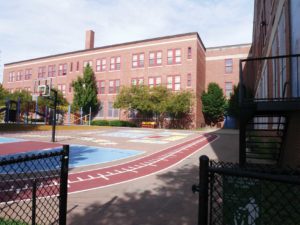On Friday, November 5th we went on our penultimate reverse field trip (for this semester), visiting two fourth grade classrooms at the Higginson/Lewis K-8 school in Roxbury, (Boston). With me were two volunteers: Mikey and Caitlyn, two PhD students in Professor Heather Brenhouse’s developmental neuropsychobiology lab and NUCLEUS graduate student members: thank you both for coming today! In today’s field trip, students learned about engineering and the design process and took their turns being engineers (solving problems), first in a bioengineering activity (egg drop) and then in an aerospace engineering activity (paper rockets).
In the egg drop activity, students learned about the human brain and how the skull and cerebrospinal fluid protects it, in the same way an egg shell and egg white protects the yolk. Students then designed a protective encasing for a falling egg, using a list of supplies and attempting to protect their eggs whilst spending the least amount of money (each material had a preset cost: the cheapest were toothpicks at $2 and the most expensive were plastic cups at $20). Students built a variety of designs -> my favorite design used toothpicks to hold the design together, rather than duct tape (which costs 3$ more). Of the 8 tested devices, 2 groups had completely intact eggs ($57 and $96 designs) and 1 group had a cracked egg but not yolk leaking out ($31 design). This lead to an interesting discussion about which design you’d rather purchase -> the cheap design that mostly works, or a more expensive design that fully works. This is also an interesting real world discussion for engineers (and beyond) in general, plus further discussions about cost-cutting and factors of safety (which we sadly didn’t have time to get into).
Lastly, students became aerospace engineers and designed paper rockets to fly as far up as possible (launched at 60 psi). Students decided three key factors in their designs: length of the rocket body, number of fins, and shape of their fins. The two winning designs both used 4 symmetrically-placed fins using small trapezoidal designs. Some interesting designs were quite visually pleasing, such as one rocket which had a huge fin (more of a “wing”) and looked more like a space shuttle than a rocket, and one design with 8 fins, but neither of these rockets launched very well. An interesting thing to note was the rockets came down very fast and landed on concrete, so the noses of the rockets all were scrunched up and the rockets were unusable a second time -> leading to a discussion about how groups could build reusable rockets in the future (parachutes) and what is currently being done in the real world in the same vein (SpaceX Starship).

